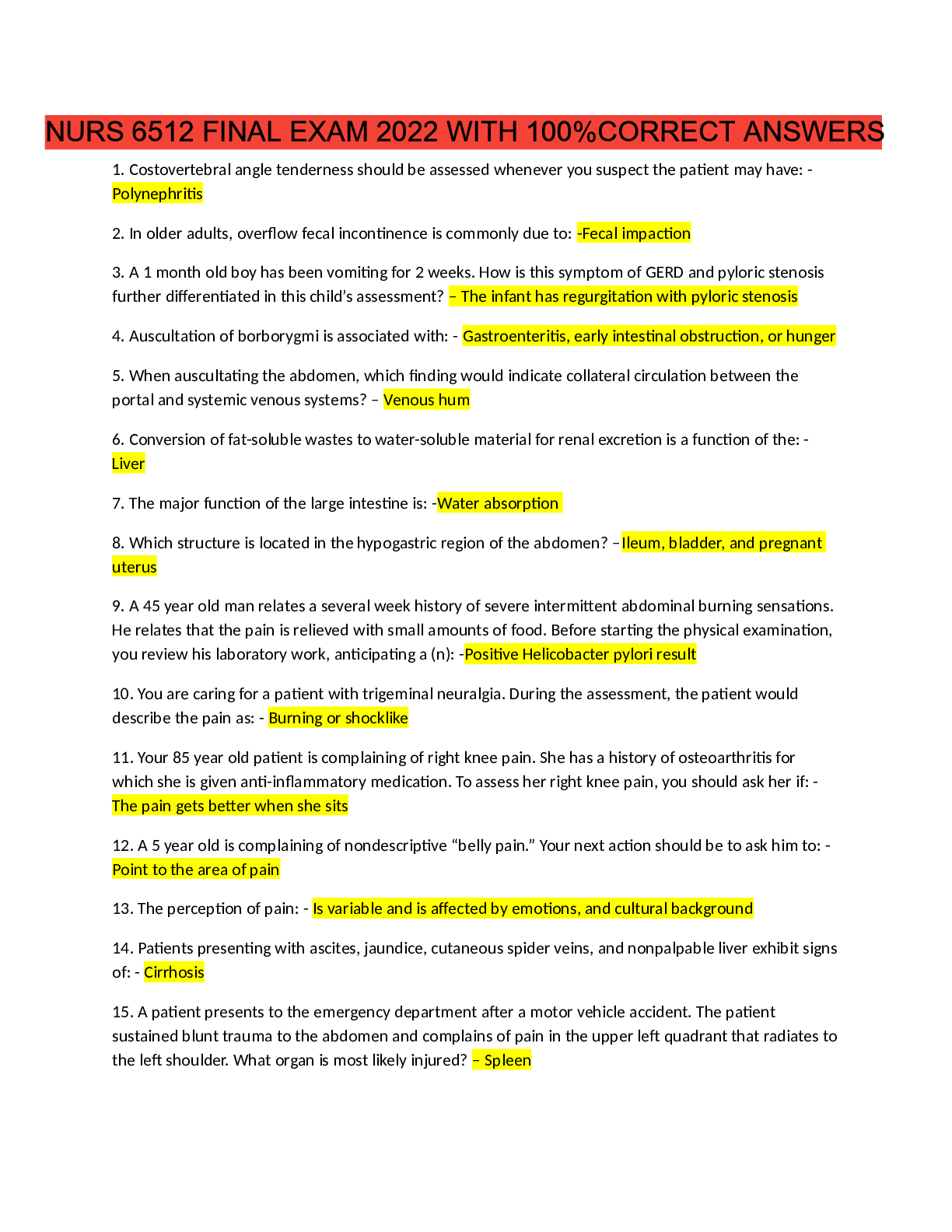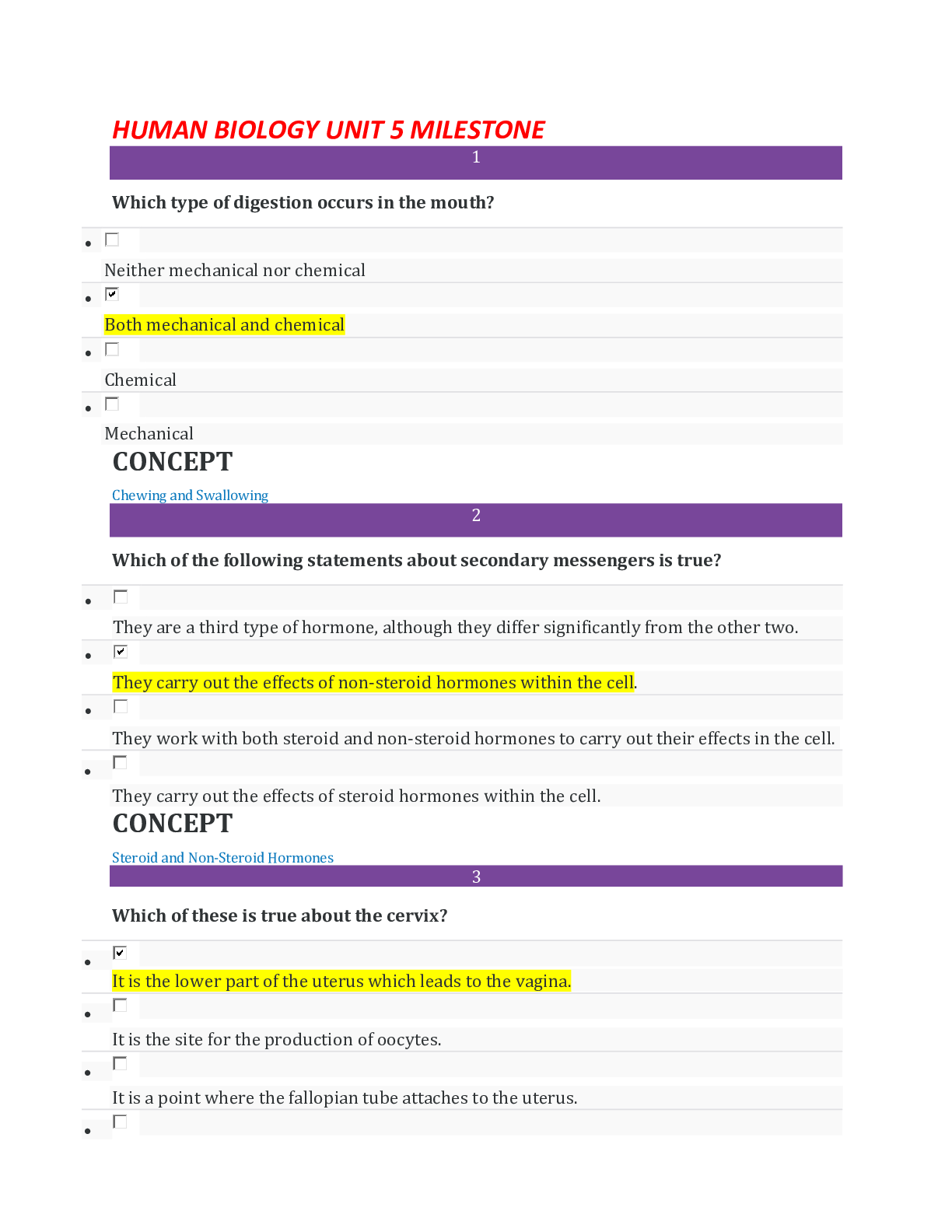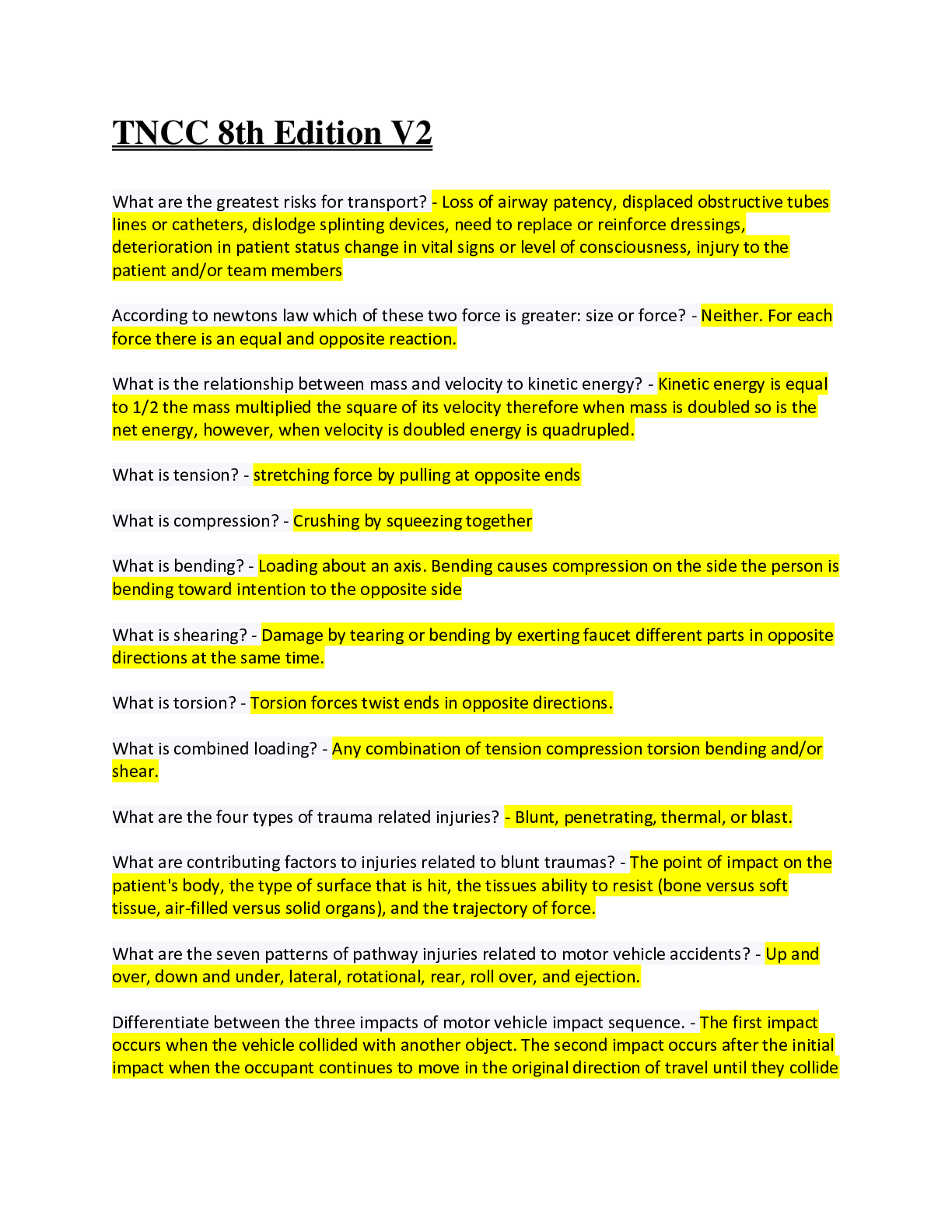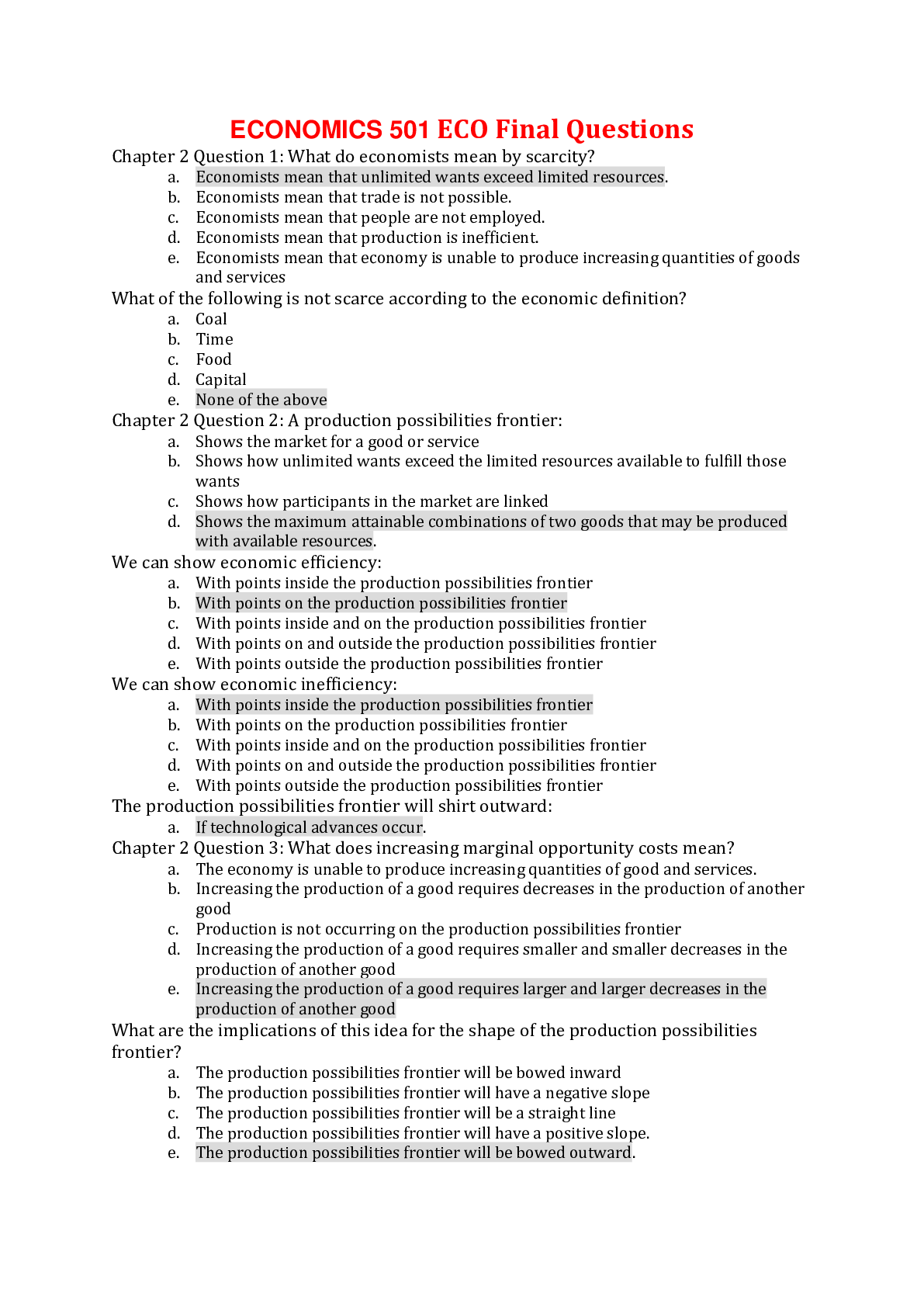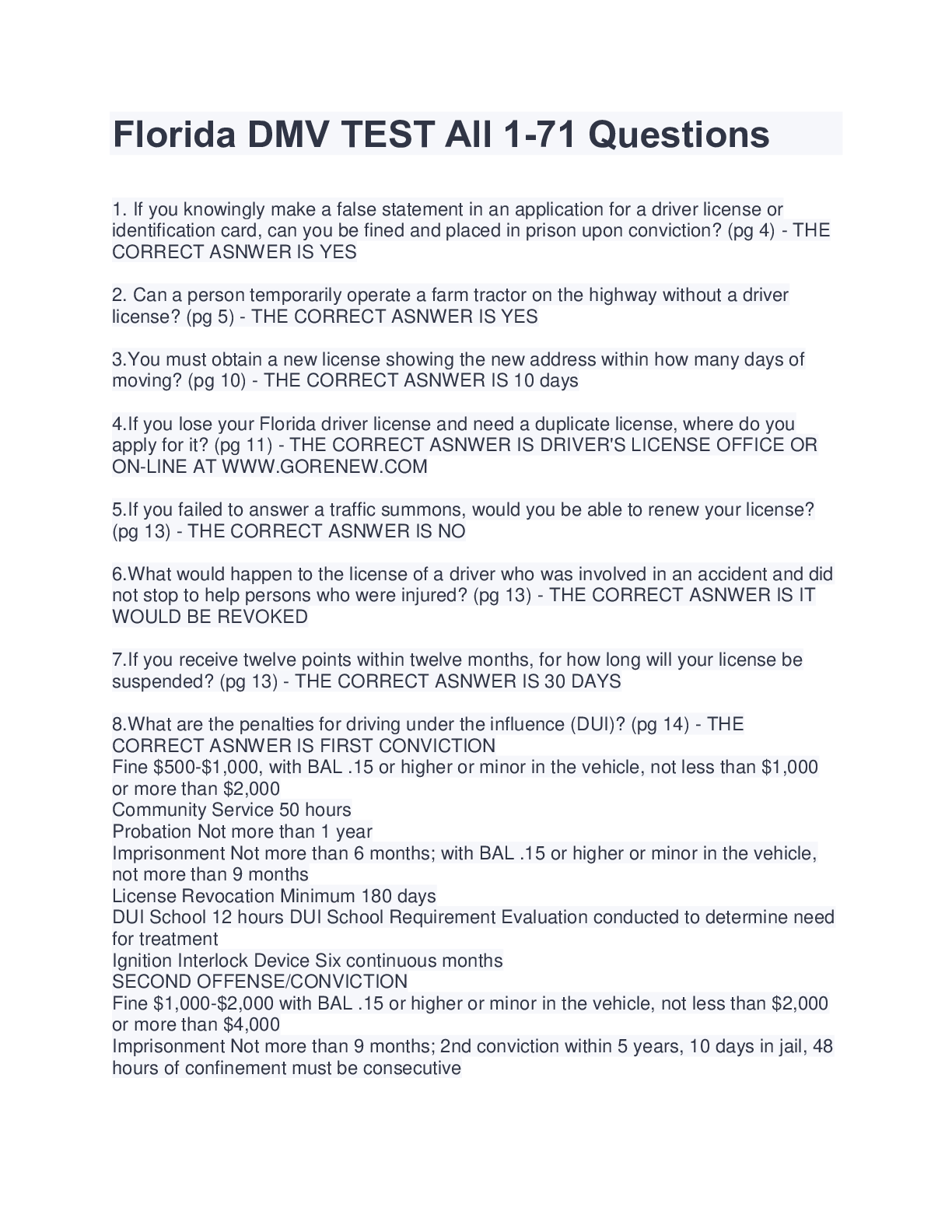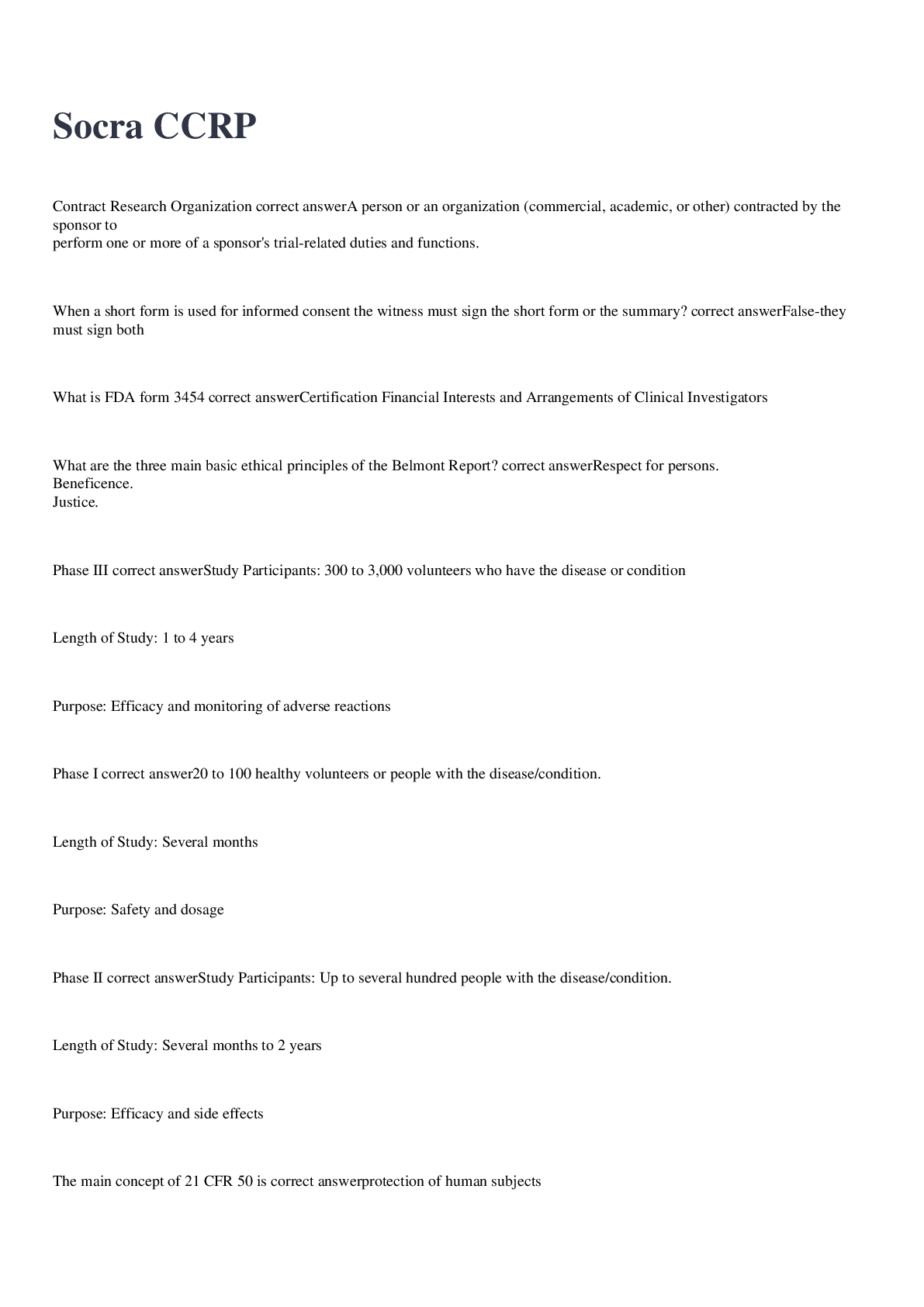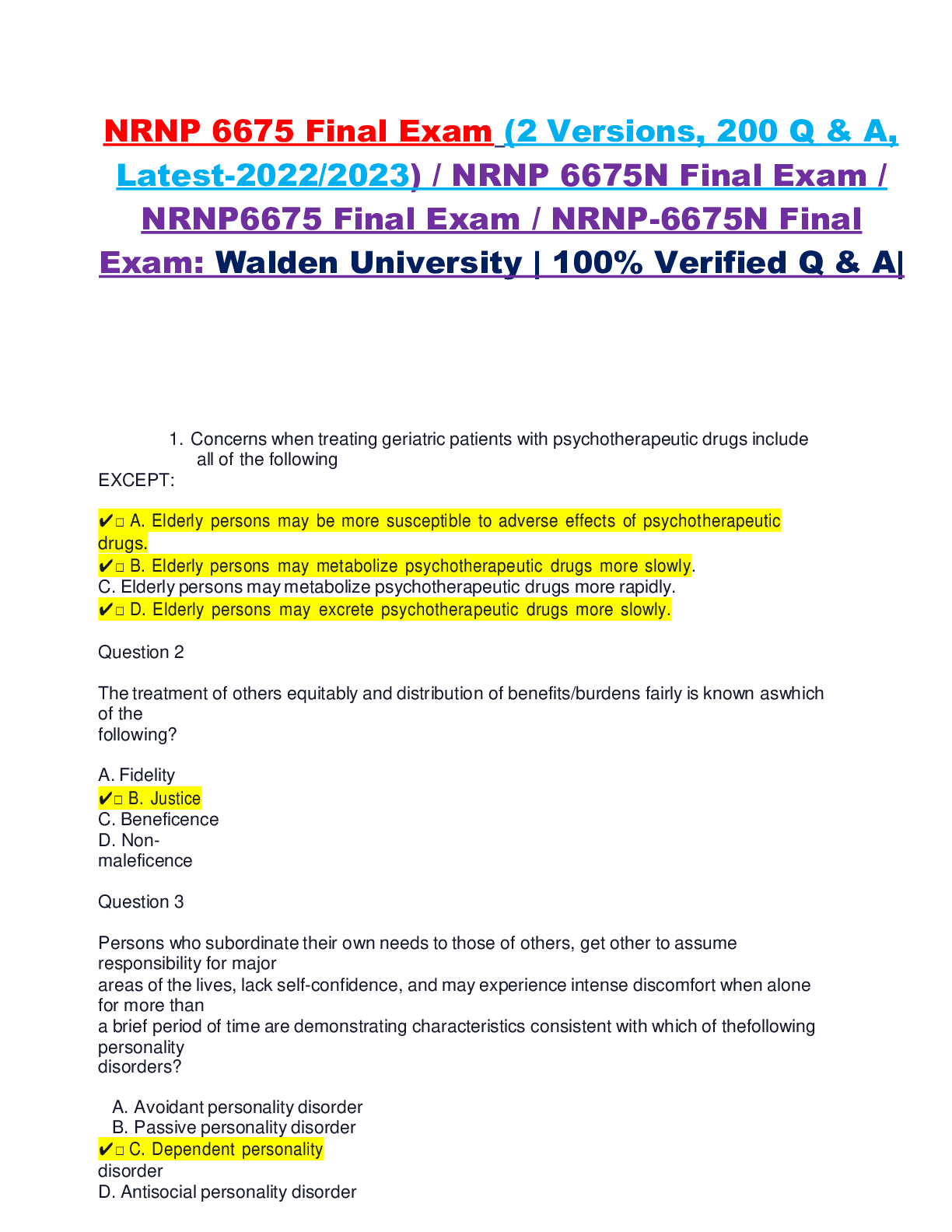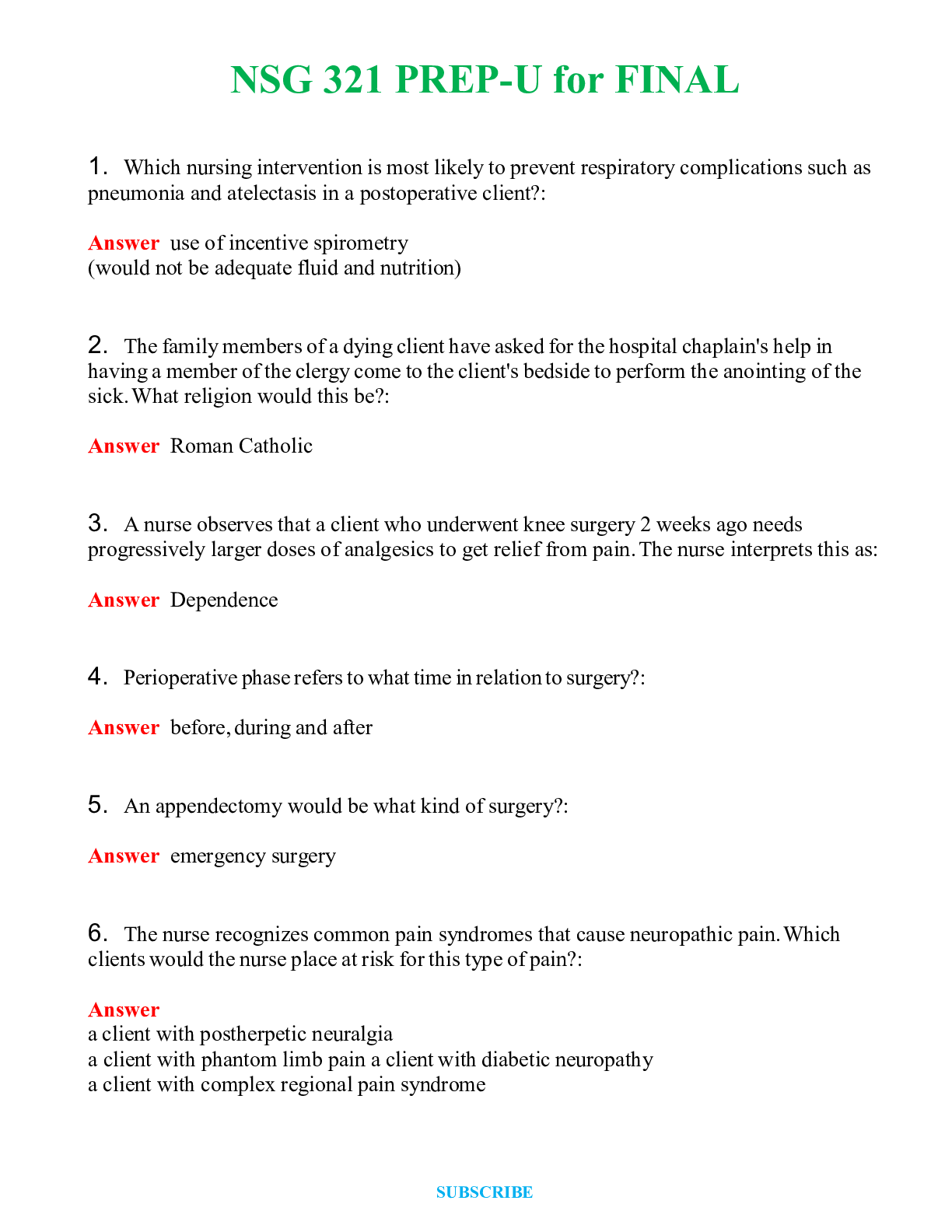Chapter 57: Drugs for Diabetes Mellitus Test Bank,100% CORRECT
Document Content and Description Below
Chapter 57: Drugs for Diabetes Mellitus Test Bank MULTIPLE CHOICE 1. The nurse working on a high-acuity medical-surgical unit is prioritizing care for four patients who were just admitted. Which... patient should the nurse assess first? a. The NPO patient with a blood glucose level of 80 mg/dL who just received 20 units of 70/30 Novolin insulin b. The patient with a pulse of 58 beats per minute who is about to receive digoxin (Lanoxin) c. The patient with a blood pressure of 136/92 mm Hg who complains of having a headache d. The patient with an allergy to penicillin who is receiving an infusion of vancomycin (Vancocin) ANS: A The NPO patient with hypoglycemia who just received 70/30 Novolin insulin takes priority, because this patient needs to consume a good source of glucose immediately or perhaps the NPO status will be discontinued for this shift. The digoxin may be withheld for the patient with a pulse of 58 beats per minute, but this is not a priority action. The patient with a headache needs to be followed up, but because the blood pressure is 136/92 mm Hg, the headache is probably not caused by hypertension. The patient with an allergy to penicillin will not have a reaction to the vancomycin. DIF: Cognitive Level: Application REF: Types of Insulin | Short Duration: Rapid Acting | Short Duration: Slower Acting | Intermediate Duration TOP: Nursing Process: Assessment MSC: NCLEX Client Needs Category: Physiologic Integrity: Reduction of Risk Potential 2. A patient with type 1 diabetes is eating breakfast at 7:30 AM. Blood sugars are on a sliding scale and are ordered before a meal and at bedtime. The patient’s blood sugar level is 317 mg/dL. Which formulation of insulin should the nurse prepare to administer? a. No insulin should be administered. b. NPH c. 70/30 mix d. Lispro (Humalog) ANS: D Regular insulin is indicated for sliding scale coverage. Insulin is definitely indicated for this high blood sugar level. NPH is used for scheduled insulin doses and is a longer acting insulin. A 70/30 mix is also used for scheduled insulin coverage. DIF: Cognitive Level: Application REF: Types of Insulin | Short Duration: Rapid Acting | Short Duration: Slower Acting | Intermediate Duration TOP: Nursing Process: Implementation MSC: NCLEX Client Needs Category: Physiologic Integrity: Reduction of Risk Potential 3. A nurse is educating the staff nurses about ketoacidosis. To evaluate the group’s understanding, the nurse asks, “Which sign and symptoms would not be consistent with ketoacidosis?” The group gives which correct answer? a. Blood glucose level of 600 mg/dL b. Blood glucose level of 60 mg/dL c. Acidosis d. Ketones in the urine ANS: B A patient with diabetic ketoacidosis (DKA) has a high glucose level (at least 500 mg/dL or higher); therefore, a glucose level of 60 mg/dL would not be consistent with DKA. A blood glucose level of 600 mg/dL, acidosis, and ketones in the urine are consistent with DKA. DIF: Cognitive Level: Analysis REF: Acute Complications of Poor Glycemic Control | Diabetic Ketoacidosis TOP: Nursing Process: Evaluation MSC: NCLEX Client Needs Category: Physiologic Integrity: Reduction of Risk Potential 4. The nurse assesses a newly diagnosed patient for short-term complications of diabetes. What does this assessment include? a. Evaluation for hyperglycemia, hypoglycemia, and ketoacidosis b. Cranial nerve testing for peripheral neuropathy c. Pedal pulse palpation for arterial insufficiency d. Auscultation of the carotids for bruits associated with atherosclerosis ANS: A High blood sugar, low blood sugar, and ketoacidosis are short-term complications of diabetes. Microvascular and macrovascular complications, such as peripheral neuropathy, are long-term complications of diabetes. Arterial insufficiency and atherosclerosis also are long-term complications of diabetes. DIF: Cognitive Level: Application REF: Short-Term Complications of Diabetes TOP: Nursing Process: Assessment MSC: NCLEX Client Needs Category: Physiologic Integrity: Reduction of Risk Potential 5. Which statement is accurate about the long-term complications of diabetes? a. Long-term complications are almost always the result of hypoglycemia and ketoacidosis. b. The complication rates for patients with tightly controlled type 2 diabetes are the same as for those whose disease is not tightly controlled. c. Tightly controlling type 1 diabetes produces excessive episodes of life-threatening hypoglycemia. d. Tightly controlling both types of diabetes reduces the risk of eye, kidney, and nerve damage. ANS: D In both types of diabetes, tightly controlling the disease slows the development of microvascular complications. Short-term complications are more apt to result from hypoglycemia and ketoacidosis. Patients with type 2 diabetes have fewer complications if their blood sugar level is tightly controlled. Hypoglycemia does not occur more frequently in patients with tightly controlled type 1 diabetes. DIF: Cognitive Level: Comprehension REF: Long-Term Complications of Diabetes TOP: Nursing Process: Planning MSC: NCLEX Client Needs Category: Physiologic Integrity: Reduction of Risk Potential 6. A patient with type 1 diabetes recently became pregnant. The nurse plans a blood glucose testing schedule for her. What is the recommended monitoring schedule? a. Before each meal and before bed b. In the morning for a fasting level and at 4 PM for the peak level c. Six or seven times a day d. Three times a day, along with urine glucose testing ANS: C A pregnant patient with type 1 diabetes must have frequent blood sugar monitoring (e.g., six or seven times a day) to manage both the patient and the fetus so that no teratogenic effects occur. Monitoring the blood sugar level before meals and at bedtime is not significant enough to provide the necessary glycemic control. Morning and 4 PM monitoring is not enough to provide glycemic control. Urine glucose testing is not sensitive enough to aid glycemic control, and monitoring 3 times a day is not enough. DIF: Cognitive Level: Application REF: Diabetes and Pregnancy TOP: Nursing Process: Planning MSC: NCLEX Client Needs Category: Physiologic Integrity: Reduction of Risk Potential 7. An adolescent patient recently attended a health fair and had a serum glucose test. The patient telephones the nurse and says, “My level was 125 mg/dL. Does that mean I have diabetes?” What is the nurse’s most accurate response? a. “Unless you were fasting for longer than 8 hours, this does not necessarily mean you have diabetes.” b. “At this level, you probably have diabetes. You will need an oral glucose tolerance test this week.” c. “This level is conclusive evidence that you have diabetes.” d. “This level is conclusive evidence that you do not have diabetes.” ANS: A If a person has not fasted for 8 hours, a blood sugar level of 125 mg/dL would be considered normal, because it is less than 200 mg/dL for a random sampling. Also, a person must have positive outcomes on two separate days to be diagnosed with diabetes. This patient does not need to have an oral glucose tolerance test, because the 125 mg/dL reading is so far below 200 mg/dL, which would require further workup. No conclusive evidence indicates that this patient has diabetes, because the random sample value is so low, and the patient has not had two separate tests on different days. However, this also is not conclusive evidence that the patient does not have diabetes. DIF: Cognitive Level: Analysis REF: Prediabetes TOP: Nursing Process: Implementation MSC: NCLEX Client Needs Category: Physiologic Integrity: Reduction of Risk Potential 8. A nurse provides dietary counseling for a patient newly diagnosed with type 1 diabetes. Which instruction should be included? a. “You may eat any foods you want and cover the glucose increase with sliding scale, regular insulin.” b. “Most of the calories you eat should be in the form of protein to promote fat breakdown and preserve muscle mass.” c. “Your total caloric intake should not exceed 1800 calories in a 24-hour period.” d. “Most of your calories should be in the form of carbohydrates and monounsaturated fats.” ANS: D Most of the calories eaten daily by a person with diabetes should be in the form of carbohydrates and monounsaturated fats. A patient with diabetes cannot eat any foods desired and then cover the glucose increase with a sliding scale of regular insulin. Protein should provide 15% to 20% of the patient’s energy intake. Every patient with diabetes must be assessed individually to determine the number of total calories the person should have daily. The total caloric intake should be spread evenly throughout the day, with meals spaced 4 to 5 hours apart. DIF: Cognitive Level: Application REF: Overview of Treatment | Type 1 Diabetes | Dietary Measures TOP: Nursing Process: Implementation MSC: NCLEX Client Needs Category: Physiologic Integrity: Reduction of Risk Potential 9. What is the most reliable measure for assessing diabetes control over the preceding 3-month period? a. Self-monitoring blood glucose (SMBG) graph report b. Patient’s report c. Fasting blood glucose level d. Glycosylated hemoglobin level ANS: D The glycosylated hemoglobin level tells much about what the plasma glucose concentration has been, on average, over the previous 2 to 3 months. The SMBG graph report is done by the patient and indicates each blood sugar level the patient has on a daily basis. It is not as reliable as the glycosylated hemoglobin level, because the equipment used might not be accurate and the testing may not reflect actual measurements 100% of the time. The patient’s report of blood sugar levels is not considered as accurate as the glycosylated hemoglobin level for the same reason that the SMBG is not. One fasting blood glucose level indicates the patient’s blood sugar level for that one time when it was obtained. DIF: Cognitive Level: Application REF: Test Based on Blood Levels of Hemoglobin A1c TOP: Nursing Process: Evaluation MSC: NCLEX Client Needs Category: Physiologic Integrity: Reduction of Risk Potential 10. A patient with type 1 diabetes reports mixing NPH and regular insulin to allow for one injection. What should the nurse tell the patient? a. This is an acceptable practice. b. These two forms of insulin are not compatible and cannot be mixed. c. Mixing these two forms of insulin may increase the overall potency of the products. d. NPH insulin should only be mixed with insulin glargine. ANS: A NPH insulin is the only insulin suitable for mixing with short-acting insulins, such as insulin aspart (NovoLog). These insulins are compatible and are mixed frequently for management of diabetics. The overall potency of each insulin is not increased by mixing them. Insulin glargine cannot be mixed with any other insulin for administration. DIF: Cognitive Level: Analysis REF: Types of Insulin | Intermediate Duration and Mixing Insulins TOP: Nursing Process: Implementation MSC: NCLEX Client Needs Category: Physiologic Integrity: Pharmacologic and Parenteral Therapies 11. Insulin glargine is prescribed for a hospitalized patient who is diabetic. When will the nurse administer this drug? a. Approximately 15 to 30 minutes before each meal b. In the morning and at 4 PM c. Once daily at bedtime d. After meals and at bedtime ANS: C Glargine insulin is indicated for once daily subcutaneous administration to treat adults and children with type 1 diabetes and adults with type 2 diabetes. According to the package labeling, the once daily injection should be given at bedtime. Glargine insulin should not be given more than once a day. DIF: Cognitive Level: Application REF: Types of Insulin | Long Duration TOP: Nursing Process: Planning MSC: NCLEX Client Needs Category: Physiologic Integrity: Pharmacologic and Parenteral Therapies 12. A patient with type 1 diabetes who takes insulin reports taking propranolol for hypertension. Why is the nurse concerned? a. The beta blocker can cause insulin resistance. b. Using the two agents together increases the risk of ketoacidosis. c. Propranolol increases insulin requirements because of receptor blocking. d. The beta blocker can mask the symptoms of hypoglycemia. ANS: D Beta blockers can delay awareness of and response to hypoglycemia by masking signs associated with stimulation of the sympathetic nervous system (e.g., tachycardia, palpitations) that hypoglycemia normally causes. Furthermore, beta blockade impairs glycogenolysis, which is one means by which the body can counteract a fall in blood glucose; beta blockers, therefore, can worsen insulin-induced hypoglycemia. Propranolol does not cause insulin resistance. The incidence of DKA is not increased by concurrent use of propranolol and insulin. Insulin requirements are not increased because of receptor blocking by propranolol. DIF: Cognitive Level: Analysis REF: Therapeutic Use | Drug Interactions TOP: Nursing Process: Diagnosis MSC: NCLEX Client Needs Category: Physiologic Integrity: Pharmacologic and Parenteral Therapies 13. Which statement is correct about the contrast between acarbose and miglitol? a. Miglitol has not been associated with hepatic dysfunction. b. With miglitol, sucrose can be used to treat hypoglycemia. c. Miglitol is less effective in African Americans. d. Miglitol has no gastrointestinal side effects. ANS: A Unlike acarbose, miglitol has not been associated with hepatic dysfunction. Sucrose should not be used to treat hypoglycemia with miglitol. Miglitol is more effective in African American patients. Miglitol has gastrointestinal side effects. DIF: Cognitive Level: Application REF: Alpha-Glucosidase Inhibitors TOP: Nursing Process: Diagnosis MSC: NCLEX Client Needs Category: Physiologic Integrity: Pharmacologic and Parenteral Therapies MULTIPLE RESPONSE 1. A patient newly diagnosed with diabetes expresses concern about losing her vision. Which interventions should be included in the plan of care to reduce this risk? (Select all that apply.) a. Initiation of reliable contraception to prevent pregnancy b. Ways to reduce hyperglycemic episodes c. Use of a prokinetic drug (e.g., metoclopramide) d. Smoking cessation e. Emphasis on the importance of taking antihypertensive drugs consistently ANS: B, D, E Tighter glycemic control and fewer hyperglycemic episodes have been correlated with fewer complications. Smoking cessation and strict compliance with any drugs prescribed for hypertension also help reduce the risk of complications. The use of contraception or a prokinetic drug is not related to a reduced risk of vision loss in patients with diabetes. DIF: Cognitive Level: Analysis REF: Long-Term Complications of Diabetes | Retinopathy TOP: Nursing Process: Planning MSC: NCLEX Client Needs Category: Health Promotion and Maintenance 2. A nurse counsels a patient with diabetes who is starting therapy with an alpha-glucosidase inhibitor. The patient should be educated about the potential for which adverse reactions? (Select all that apply.) a. Hypoglycemia b. Flatulence c. Elevated iron levels in the blood d. Fluid retention e. Diarrhea ANS: B, E Acarbose and miglitol frequently cause flatulence, cramps, abdominal distention, borborygmus (rumbling bowel sounds), and diarrhea. Acarbose also can cause liver damage. Neither acarbose nor miglitol causes hypoglycemia, elevated iron levels, or fluid retention. DIF: Cognitive Level: Application REF: Alpha-Glucosidase Inhibitors TOP: Nursing Process: Implementation MSC: NCLEX Client Needs Category: Physiologic Integrity: Pharmacologic and Parenteral Therapies [Show More]
Last updated: 1 year ago
Preview 1 out of 8 pages
.png)
Reviews( 0 )
Document information
Connected school, study & course
About the document
Uploaded On
Apr 11, 2021
Number of pages
8
Written in
Additional information
This document has been written for:
Uploaded
Apr 11, 2021
Downloads
0
Views
29




